Family name: Alistmataceae Vent.
Synonym(s): Damasoniaceae Nakai; Limnocharitaceae Takht. ex Cronquist
Common name(s): water-plantain family
*Number of genera/species: 17/115
fruit (one-seeded) or seed
Fruit a folliclefollicle:
a dry to (rarely) fleshy fruit derived from a single carpel that opens along a single longitudinal suture, derived from a single, superior, simple ovary; the seeds may be arillate or with a fleshy testa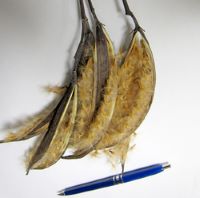 (Butomopsis, Hydrocleys and Limnocharis), aggregate of folliclesfollicle:
(Butomopsis, Hydrocleys and Limnocharis), aggregate of folliclesfollicle:
a dry to (rarely) fleshy fruit derived from a single carpel that opens along a single longitudinal suture, derived from a single, superior, simple ovary; the seeds may be arillate or with a fleshy testa (Damasonium), or an acheneachene:
(Damasonium), or an acheneachene:
a dry, indehiscent, one-seeded fruit, with seed attached to pericarp at a single point, derived from a single, superior, simple or compound, one-loculed ovary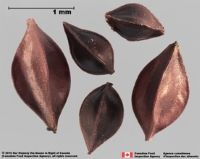 , 0.8–45 mm long, linearlinear:
, 0.8–45 mm long, linearlinear:
(shape) long, narrow, and uniform in width; (of embryo) embryo is straight and much longer than wide to trigonoustrigonous:
to trigonoustrigonous:
3D shape—having three faces that meet at distinct angles; triangular in outline
, compressedcompressed:
flattened; in grasses, used to denote compression (not necessarily flattened) either laterally or dorsiventrally
, tereteterete:
approximately circular in cross section; width and thickness approximately equal
 , or angularangular:
, or angularangular:
2D shape—having sides that meet at acute or obtuse angles
in transection, often beakedbeak:
a usually firm, terminal appendage, sometimes tapered , sometimes with one laterallateral:
, sometimes with one laterallateral:
(of embryo) embryo lies along the side of the seed, generally towards one end; of, at, or from the side; in grasses, can refer to the sides adjacent to the dorsal and ventral sides
wing, with one (acheneachene:
a dry, indehiscent, one-seeded fruit, with seed attached to pericarp at a single point, derived from a single, superior, simple or compound, one-loculed ovary ) to many seeds (folliclefollicle:
) to many seeds (folliclefollicle:
a dry to (rarely) fleshy fruit derived from a single carpel that opens along a single longitudinal suture, derived from a single, superior, simple ovary; the seeds may be arillate or with a fleshy testa ). Pericarp yellow to black, dulldull:
). Pericarp yellow to black, dulldull:
reflecting only a low proportion of incident light, with no apparent sheen , glabrousglabrous:
, glabrousglabrous:
without hairs
or pubescentpubescent:
surface relief—bearing hairs
, smooth, ridged, wartywarty:
surface relief—distinct, rounded projections that are large relative to the fruit size; tuberculate, verrucose , spinyspiny:
, spinyspiny:
having slender, stiff, sharp projections oriented in the general plane of the structure , ribbedribbed:
, ribbedribbed:
surface relief—wide, prominent, linear ridges that are generally rounded and longitudinally situated on the surface , or groovedgrooved:
, or groovedgrooved:
surface relief—linear depressions that may be single or form a series of grooves over the surface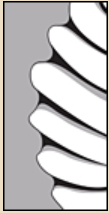 , sometimes glandularglandular:
, sometimes glandularglandular:
surface relief—covered with small, raised secretory glands, regular or irregularly shaped, translucent or opaque, and maybe distinctly colored . In Damasonium, 6-10 folliclesfollicle:
. In Damasonium, 6-10 folliclesfollicle:
a dry to (rarely) fleshy fruit derived from a single carpel that opens along a single longitudinal suture, derived from a single, superior, simple ovary; the seeds may be arillate or with a fleshy testa are clustered and appear star-shapedstar-shaped:
are clustered and appear star-shapedstar-shaped:
(of fruit), having a distal aspect like the stylized shape of a star, usually found in aggregate versus simple fruit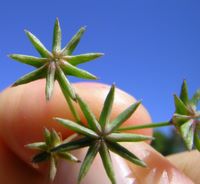 at maturity but usually fall singly.
at maturity but usually fall singly.
Seeds variously shaped, compressedcompressed:
flattened; in grasses, used to denote compression (not necessarily flattened) either laterally or dorsiventrally
to tereteterete:
approximately circular in cross section; width and thickness approximately equal
 in transection, 1–7 mm long. Seed coat brown, thin, membranousmembranous:
in transection, 1–7 mm long. Seed coat brown, thin, membranousmembranous:
texture—extremely thin, pliable, and fairly tough
, smooth, striate to ribbedribbed:
surface relief—wide, prominent, linear ridges that are generally rounded and longitudinally situated on the surface , wartywarty:
, wartywarty:
surface relief—distinct, rounded projections that are large relative to the fruit size; tuberculate, verrucose , or spinyspiny:
, or spinyspiny:
having slender, stiff, sharp projections oriented in the general plane of the structure , sometimes glandularglandular:
, sometimes glandularglandular:
surface relief—covered with small, raised secretory glands, regular or irregularly shaped, translucent or opaque, and maybe distinctly colored . Hydrocleys seeds are sparsely to densely glandular-pubescent.
. Hydrocleys seeds are sparsely to densely glandular-pubescent.
Embryo strongly curvedcurved:
(of embryo) linear embryo is curved into an arch or horseshoe with the ends far apart to horseshoe-shapedhorseshoe-shaped:
to horseshoe-shapedhorseshoe-shaped:
3D shape—relatively slender and strongly compressed, the whole strongly curved over its length in a plane perpendicular to the direction of compression and forming an incomplete circle, the ends somewhat straighter than the rest and parallel or nearly so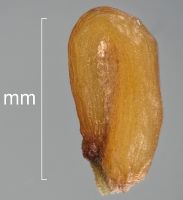 , often visible through seed coat.
, often visible through seed coat.
Endosperm lacking.
Noxious Weed: USA Federal Noxious Weed List, Sagittaria sagittifolia L..
More available on the Table Grape Weed Disseminuledisseminule:
detachable plant part capable of being disseminated and of propagating, commonly a seed or fruit
I.D. and Aquarium & Pond Plants of the World (APPW). Weedy or malignant in paddy fields, marshes, channels, and ponds spreading by seed reproduction and stolon and bulb propagation.
| Fruit | |
| Type | acheneachene: a dry, indehiscent, one-seeded fruit, with seed attached to pericarp at a single point, derived from a single, superior, simple or compound, one-loculed ovary  , folliclefollicle: , folliclefollicle:a dry to (rarely) fleshy fruit derived from a single carpel that opens along a single longitudinal suture, derived from a single, superior, simple ovary; the seeds may be arillate or with a fleshy testa  |
| Size range | 0.8–45 mm long |
| Shape(s) | globoseglobose: 3D shape—more or less spherical  , ellipsoidellipsoid: , ellipsoidellipsoid:3D shape—elliptic , ovoidovoid: 3D shape—ovate  , linearlinear: , linearlinear:(shape) long, narrow, and uniform in width; (of embryo) embryo is straight and much longer than wide  , lanceoloidlanceoloid: , lanceoloidlanceoloid:3D shape—lanceolate , cylindricalcylindrical: 3D shape—a cylinder, with parallel sides and a circular cross-section; tubular or rod-shaped , trigonoustrigonous: 3D shape—having three faces that meet at distinct angles; triangular in outline , reniformreniform: 2D or 3D shape—kidney-shaped  |
| Texture | membranousmembranous: texture—extremely thin, pliable, and fairly tough , spongyspongy: soft, light, discontinuous but cohesive, and somewhat resilient |
| Surface relief | smooth or glandularglandular: surface relief—covered with small, raised secretory glands, regular or irregularly shaped, translucent or opaque, and maybe distinctly colored  , ridgedridged: , ridgedridged:surface relief—raised, thick ridges, sharp edged or rounded, usually in a series that may cover the entire surface  , wartywarty: , wartywarty:surface relief—distinct, rounded projections that are large relative to the fruit size; tuberculate, verrucose  , spinyspiny: , spinyspiny:having slender, stiff, sharp projections oriented in the general plane of the structure  , ribbedribbed: , ribbedribbed:surface relief—wide, prominent, linear ridges that are generally rounded and longitudinally situated on the surface  , groovedgrooved: , groovedgrooved:surface relief—linear depressions that may be single or form a series of grooves over the surface  |
| Color(s) | black, brown, yellow |
| Unique features | Genera can be identified based on ornamentation of pericarppericarp: fruit wall or fruit coat . |
| Seed | |
| Size range | 1–7 mm long |
| Shape(s) | curvedcurved: (of embryo) linear embryo is curved into an arch or horseshoe with the ends far apart  , hippocrepiformhippocrepiform: , hippocrepiformhippocrepiform:3D shape—horseshoe-shaped , oblongoblong: 2D shape—much longer than broad with nearly parallel sides, corners are rounded  , ellipsoidellipsoid: , ellipsoidellipsoid:3D shape—elliptic , ovoidovoid: 3D shape—ovate  , conicalconical: , conicalconical:3D shape—cone-shaped, with the point of attachment at the broad end  , polygonalpolygonal: , polygonalpolygonal:angular |
| Surface relief | smooth, striatestriate: surface relief—having fine, parallel lines, grooves or ridges  , ridgedridged: , ridgedridged:surface relief—raised, thick ridges, sharp edged or rounded, usually in a series that may cover the entire surface  , ribbedribbed: , ribbedribbed:surface relief—wide, prominent, linear ridges that are generally rounded and longitudinally situated on the surface  , spinyspiny: , spinyspiny:having slender, stiff, sharp projections oriented in the general plane of the structure  , wartywarty: , wartywarty:surface relief—distinct, rounded projections that are large relative to the fruit size; tuberculate, verrucose  , glandularglandular: , glandularglandular:surface relief—covered with small, raised secretory glands, regular or irregularly shaped, translucent or opaque, and maybe distinctly colored  , sometimes pubescentpubescent: , sometimes pubescentpubescent:surface relief—bearing hairs |
| Color(s) | brown |
| Unique features | Seeds with strongly curvedcurved: (of embryo) linear embryo is curved into an arch or horseshoe with the ends far apart  embryos visible through seed coat. embryos visible through seed coat. |
| Other | |
| Embryo | strongly curvedcurved: (of embryo) linear embryo is curved into an arch or horseshoe with the ends far apart  , large , large |
| Nutritive tissue | endosperm lacking |
Nearly worldwide distribution. Occurs throughout most of the Americas including the West Indies, Eurasia, Africa, Indian Ocean Islands, and Australia.
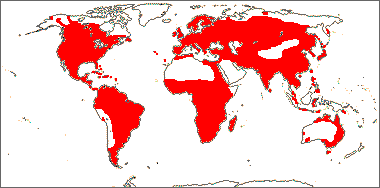
Distribution map courtesy of Angiosperm Phylogeny Website.
Baskin and Baskin 2021Baskin and Baskin 2021:
Baskin C and Baskin J. 2021. Relationship of the lateral embryo (in grasses) to other monocot embryos: A status up-grade. Seed Science Research 31 (3): 199-210. doi:10.1017/S0960258521000209; Carter 1960Carter 1960:
Carter S. 1960. Alismataceae. In: Hubbard CE and Milne-Redhead E, eds. Flora of Tropical East Africa. Vol 4. Crown Agents for Oversea Governments and Administrations, London UK. 16 pp.; Dahlgren et al. 1985Dahlgren et al. 1985:
Dahlgren RMT, Clifford HT, and Yeo PF. 1985. The families of the monocotyledons: structure, evolution, and taxonomy. Springer-Verlag, Berlin. 520 pp.; Flora of Australia 2021+Flora of Australia 2021+:
Flora of Australia. Australian Biological Resources Study, Canberra. Accessed January 2021–March 2024. URL: http://www.ausflora.org.au; Flora of North America Editorial Committee 1993+Flora of North America Editorial Committee 1993+:
Flora of North America Editorial Committee, eds. 1993+. Flora of North America North of Mexico [Online]. 22+ vols. Flora of North America Association, New York and Oxford. Accessed January-March 2024. URL: http://beta.floranorthamerica.org.; Kirkbride et al. 2006Kirkbride et al. 2006:
Kirkbride JH, Jr, Gunn CR, and Dallwitz MJ. 2006. Family guide for fruits and seeds, vers. 1.0. Accessed September 2020-January 2022. URL: https://nt.ars-grin.gov/seedsfruits/keys/frsdfam/index.cfm .; Noxious Weed Regulations 2020Noxious Weed Regulations 2020:
Noxious Weed Regulations. 2020. 7 C.F.R. sect; 360.100-360.600.; Thiele and Adams 2014Thiele and Adams 2014:
Thiele KR and Adams LG. 2014. Families of Flowering Plants of Australia. Accessed January-December 2021. URL: https://keys.lucidcentral.org/keys/v3/FFPA/key/FFPA/Media/Html/index.htm; Zhengyi et al. 2004+Zhengyi et al. 2004+:
Zhengyi W, Raven PH, and Deyuan H. 2004+. Flora of China [online]. 25 vols. Science Press, Beijing China & Missouri Botanical Garden, St. Louis USA. Accessed January–March 2024. http://flora.huh.harvard.edu/china/; Zomlefer 1994Zomlefer 1994:
Zomlefer WB. 1994. Guide to Flowering Plant Families. The University of North Carolina Press, Chapel Hill. 430 pp.
*The number of genera and species is based on Christenhusz and Byng 2016Christenhusz and Byng 2016:
Christenhusz MJM and Byng JW. 2016. The number of known plant species in the world and its annual increase. Phytotaxa 261 (3): 201-217. https://doi.org/10.11646/phytotaxa.261.3.1, which may differ from the number of genera in GRIN-Global.